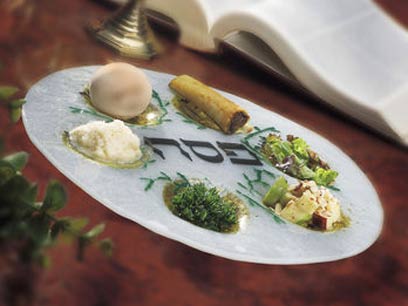

Marking the Hebrews' exodus from slavery in Egypt, Passover – which is one of Judaism's Three Pilgrimage Festivals, or Shloshet Haregalim – is celebrated during the Jewish month of Nisan, which usually coincides with the month of April.
The biblical text explains the origin of the name: "Then tell them, 'It is the Passover sacrifice to the Lord, who passed over the houses of the Israelites in Egypt and spared our homes when he struck down the Egyptians.' Then the people bowed down and worshiped". (Exodus 12:27)
And later, goes on to determine the holiday as one of the Three Pilgrimage Festivals: "These are the Lord's appointed feasts, the sacred assemblies you are to proclaim at their appointed times: The Lord's Passover begins at twilight on the fourteenth day of the first month. On the fifteenth day of that month the Lord's Feast of Unleavened Bread begins; for seven days you must eat bread made without yeast. On the first day hold a sacred assembly and do no regular work. For seven days present an offering made to the Lord by fire. And on the seventh day hold a sacred assembly and do no regular work." (Leviticus 23: 4-8)
The holiday also marks the formation of Israel as an independent nation, and is also referred to as the "Festival of Freedom" and "Festival of Spring."
During the seven days of Passover, the eating of breads of any kind is forbidden. Instead, Jews are ordered to eat matzot as a symbol of remembrance to the food the ancient Israelites ate whilst making their journey across the desert.

The Seder plate (Photo: Liquid Library)
Furthermore, being in possession of leavened of any kind is forbidden and prior to the holiday, Jews must get rid of all of it: Any bread found must be burnt in a special ritual called the "removal of leavened bread". The ban goes as far as ordering no dishes and cutlery used on a day-to-day basis be used during the holiday, for fear they may carry any leavened residue.
The day of Passover is followed by six days of festival weekdays, climaxing at the second day of Passover, also known as "Little Passover."
it is believed that Passover was originally celebrated as an agricultural festival, marking the onset of spring and harvest season, and that the religious symbolism of it marking the day of deliverance for Jews from the Egyptian slavery was added on in later times.
It is customary to celebrate Passover with a big meal, called the Seder, during which Jews are ordered to carry out the mitzvah of telling the story of Passover by reading the Haggadah – the orders of Passover.
Additional Seder orders call for eating matzot, Marror – which are bitter herbs, Karpas – traditionally parsley or celery , Charoset - which is a sweet, dark-colored paste and hiding the Afikoman - a piece of matzah traditionally hidden early on in the Seder for the children to find.
Beginning on the second night of Passover and on the 16th day of Nisan the practice of the Counting of the Omer begins. The 50-day count serves as a reminder of the approaching holiday of Shavuot.














